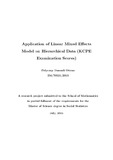Application of Linear Mixed E ects Model on Hierarchical Data (KCPE Examination Scores)
Abstract
Over the last four decades, the mixed e ects model has gained prominence in so-
cial research in education, health and elds whose data naturally have hierarchical
structures. The ability of the mixed e ects model to handle unbalanced clustered
data as well as providing analysis of within groups and between groups variations
have been behind the growing inclination to the use of this model. Prior to its
development, the standard linear regression model had been immensely employed
in modeling e ects or in
uence of selected factors on the observed phenomena.
Hierarchical data structures have subjects nested within groups, a fact that intro-
duces correlation between subjects of the same group and calls for the application
of an appropriate model that su ciently explains the origin of variations.
In this study the linear mixed e ects model is applied in the analysis of national
examination scores for pupils who sat for that examination in 2013. The number of
pupils in each of the sampled schools is variant. The imbalance in the data struc-
ture inhibits the application of models like multivariate regression or the ANOVA
model and therefore stresses the choice for the linear mixed e ects model. The
research project builds a suitable linear mixed e ects model that explains the dis-
tribution of the observed examination scores given pupils'individual characteristics
as well as school level characteristics.
The structure of the data used in this study is nested. Insight is provided for the
process of choosing xed and random e ects variables and the Akaike Information
ix
Criterion is used in selecting the optimal model used the analysis. The adequacy
of the selected model is assessed using the Likelihood Ratio Test which compares
the likelihood functions of the selected model and a restricted null model. The
Restricted Maximum Likelihood Method has been considered for the estimation
of variance components of the model. The Best Linear Unbiased Estimator is em-
ployed in the estimation of the xed e ects parameters while the estimates of the
random e ects parameters are predicted using the Best Linear Unbiased Predic-
tor. Finally, the results of the analysis have been presented with xed and random
coe cients and interpretation given for the results.

